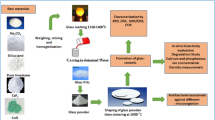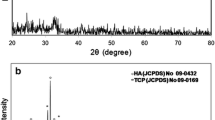Abstract
The antibacterial activity of ZnO (0–15.53 mol%) based SiO2–CaO–P2O5–Na2O–CaF2 bioactive glass–ceramics synthesized by controlled crystallisation were studied against eight micro-organisms using modified Kirby Bauer method. The antibacterial activity of the specimens was statistically evaluated using one-way analysis of variance and P < 0.05 was used as the level of significance. In vitro dissolution tests were performed in stimulated body fluid for 48 h at 37 °C for different time intervals to correlate the dissolution behaviour of test samples with antibacterial effects. The results illustrate that specimen BZn15.53 having the highest concentration of ZnO (15.53 mol %) demonstrated the strongest effect against Staph.aureus, S. epidermidis, B. subtilis and K. pneumonia. The effectiveness of BZn15.53 in inhibiting bacteria was due to accumulation of Zn+2 ions around the surface of the bacteria cell release that caused the death of the cell, besides the presence of hydroxyapatite phase was also responsible for damaging the cell membrane of bacteria.







Similar content being viewed by others
References
Lin H, Zhang J, Qu F, Jiang J, Jiang P. In vitro hydroxyapatite-forming ability and antimicrobial properties of mesoporous bioactive glasses doped with Ti/Ag. J Nanomater. 2013; Article ID 786420, 1–8.
Bellantone M, Williams HD, Hench LL. Broad-spectrum bactericidal activity of Ag2O-doped bioactive glass. Antimicrob Agents Chemother. 2002;46:1940–5.
Gristina AG. Biomaterial-centered infection: microbial adhesion versus tissue integration. Science. 1987;237:1588–95.
Balamurugan A, Balossier G, Laurent-Maquin D, Pina S, Rebelo AHS, Faure J, Ferreira JMF. An in vitro biological and anti-bacterial study on a sol–gel derived silver-incorporated bioglass system. Dent Mater. 2008;24:1343–51.
Díaz M, Barba F, Miranda M, Guitián F, Torrecillas R, Moya JS. Synthesis and antimicrobial activity of a silver-hydroxyapatite nanocomposite. J Nano Mat. 2009;14:1–6.
Ahmed AA, Ali AA, Mahmoud DAR, El-Fiqi AM. Preparation and characterization of antibacterial P2O5–CaO–Na2O–Ag2O glasses. J Biomed Mater Res Part A. 2011;98(1):132–42.
Mustaffa R, Yusof MR, Othman F, Rahmat A. Drug release study of porous hydroxyapatite coated gentamycin- as drug delivery system. Regen Res. 2012;1(2):61–7.
Gorriti M, Lopez JMP, Boccaccini AR, Audisio C, Gorustovich AA. In vitro study of the antibacterial activity of bioactive glass-ceramic scaffolds. Adv Eng Mater. 2009;11(7):67–70.
Zhang D, Munukka E, Hupa L, Ylänen H, Matti K. Factors controlling antibacterial properties of bioactive glasses. Key Eng Mater. 2007;330–332:173–6.
Allan I, Newman H, Wilson M. Antibacterial activity of particulate Bioglass® against supra- and subgingival bacteria. Key Eng Mater. 2001;22:1683–7.
Shirashi F, Toyada K, Fukinbara S. Photolytic Smf pfotocatalytic treatment of an aqueous solution containing microbial cells and organic compounds in an annular-flow reactor. Chem Eng Sci. 1999;54:1547–52.
Stefan R, Mihaela N, Spinu M, Popescu S. Antibacterial effect of ZnO-B2O3 Matrix Doped with Silver Ions on Gram Positive Bacteria Cultures. J Anim Sci Biotechnol. 2010;1:43.
Jafari A, Ghane M, Arastoo S. Synergistic antibacterial effects of nano zinc oxide combined with silver nanocrystales. Afr J Microbiol Res. 2011;5:5465–73.
Azam A, Ahmed AS, Oves M, Khan MS, Habib SS, Memic A. Antimicrobial activity of metal oxide nanoparticles against gram-positive and gram-negative bacteria: a comparative study. Int J Nanomed. 2012;7:6003–9.
Hench LL, Wilson J. An introduction to bioceramics, advanced series in ceramics, vol. 1. Singapore: World Scientific Publishing; 1993.
Kokubo T, Shigematsu M, Nagashima Y, Tashiro M, Nakamura T, Yamamuro T, Higashi S. Apatite- and wollastonite-containg glass-ceramics for prosthetic application. Bull Ins Chem Res. 1982;60(3–4):260–8.
Yoshimi T, Sugiyama N, Takeoka Y, Rikukawa M, Oribe K, Aizawa M. Changes of material properties of inorganic/organic hybrids fabricated by infiltration of poly(l-lactic acid) into open pores of porous hydroxyapatite ceramics in a simulated body fluid. J Aus Ceram Soc. 2011;47(1):18–22.
Kokubo T, Kitsugi T, Yamamuro T. Solution able to reproduce in vivo surface-structure changes in bioactive glass-ceramics A-W. J Biomed Mater Res. 1990;24:721–34.
Hench LL. Bioceramics: from concept to clinic. J Am Ceram Soc. 1991;74:1487–510.
Fujita H, Iida H, Ido K, Matsuda Y, Oka M, Nakamura T. Porous apatite-wollastonite glass-ceramic as an intramedullary plug. J Bone Joint Surg [Br]. 2000;82(4):614–8.
Salman SM, Salama SN, Darwish H, Abo-Mosallam HA. In vitro bioactivity of glass-ceramics of the CaMgSi2O6-CaSiO3-Ca5(PO4)3F-Na2SiO3 system with TiO2 or ZnO additives. Ceram Int. 2009;35:1083–93.
Kamitakahara M, Ohtsuki C, Inada H, Tanihara M, Miyazaki T. Effect of ZnO addition on bioactive CaO–SiO2–P2O5–CaF2 glass-ceramics containing apatite and wollastonite. Acta Biomater. 2006;2:467–71.
Saino E, Grandi S, Quartarone E, Maliardi V, Galli D, Bloise N, Fassina L, Gabriella M, De Angelis C, Mustarelli P, Imbriani M, Visai L. In vitro calcified matrix deposition by human osteoblasts onto a zinc-containing bioactive glass. Eur Cell Mater. 2011;21:59–72.
Riaz M, Zia R, Saleemi F, Bashir F, Hossain T, Kayani Z. In vitro evaluation of bioactivity of SiO2–CaO–P2O5–Na2O–CaF2–ZnO glass-ceramics. Mat Sci Poland. 2014;32(3):364–74.
Hench LL. The story of bioglass. J Mat Sci. 2006;17(11):967–78.
Zia R, Riaz M, Maqsood S, Anjum S, Kayani Z, Hussain T. Titania doped bioactive ceramics prepared by solid state sintering method. Ceram Int. 2015;41:8964–72.
Sawi J. Quantitative evaluation of antibacterial activities of metallic oxide powders (ZnO, MgO and CaO) by conductimetric assay. J Microbiol Methods. 2003;54:177–82.
Sevinç BA, Hanley L. Antibacterial activity of dental composites containing zinc oxide nanoparticles. J Biomed Mater Res Part B. 2010;94:22–31.
Kokubo T, Shigematsu M, Nagashisma Y, Tashiro M, Nakamura T, Yamamuro T, Higashi S. Apatite- and wallostonite-containing glass-ceramics for prosthetic application. Bull Inst Chem Res. 1982;60(3–4):260–8.
Jones N, Ray B, Ranjit KT, Manna AC. Antibacterial activity of ZnO nanoparticles suspensions on a broad spectrum of microorganisms. FEMS Microbiol Lett. 2008;279:71–6.
Premanthan M, Karthikeyan K, Jeyasubramanian K, Manivannam G. Selective toxicity of ZnO nanoparticles towards Gram-positive bacteria and cancer cells by apoptosis through lipid peroxidation. Nanomedicine. 2011;7:184–92.
Bauer AW, Kirby WMH, Sherris JC, Trunk M. Antibioatic succeptability testing by a standardized single disc method. Am J Clin Pathol. 1966;45:493–6.
Kokubo T, Takadama H. How useful is SBF in predicting in vivo bone bioactivity? Biomaterials. 2006;27(15):2907–15.
Deepa C, Begum AN, Aravindan S. Preparation and antimicrobial observations of zinc doped nanohydroxyapatite. Nanosist FiZ Himmat. 2013;4(3):370–7.
Driscoll AJ, Bhat N, Karron RA, O’Brien KL, Murdoch DR. Disk diffusion bioassays for the detection of antibiotic activity in body fluids: applications for the pneumonia etiology research for child health project. Clin Infect Dis. 2012;54(S2):159–64.
Stoor P, Soderling E, Salonen JI. Antibacterial effects of a bioactive glass paste on oral microorganisms. Acta Odontol Scand. 1998;56:161–5.
Stoor P, Soderling E, Grenman R. Interations between bioactive glass S53P4 and the atrophic rhinitis-associated microoganism klebsiella ozaenae. J Biomed Mater Res B Appl Biomater. 1999;48:869–74.
Zehnder M, Baumgartner G, Marquardt K, Paque F. Prevention of bacterial leakage through instrumented root canals by bioactive glass S53P4 and calcium hydroxide suspension in vitro. Oral Surg Oral Med Oral Pathol Oral Radiol Endod. 2007;103:423–8.
Jesline A, John NP, Narayanan PM, Vani C, Murugan S. Antimicrobial activity of zinc and titanium dioxide nanoparticles against biofilm-producing methicillin-resistant Staphylococcus aureus. Appl Nanosci. 2015;5:157–62.
Nies DH. Microbial heavy-metal resistance. Appl Microbiol Biotechnol. 1999;51(6):730–50.
Hu S, Chang J, Liu M, Ning C. Study on antibacterial effect of 45S5 Bioglass. J Mater Sci Mater Med. 2009;20(1):281–6.
Adwan K, Abu-Hasan N. Gentamicin resistance in clinical strains of Enterobacteriaceae associated with reduced gentamicin uptake. Folia Microbiol. 1998;43:438–40.
Acknowledgments
The authors acknowledge the Post Graduate Medical Institute (PGMI) Lahore, Pakistan for providing pure bacterial cultures.
Author information
Authors and Affiliations
Corresponding author
Rights and permissions
About this article
Cite this article
Riaz, M., Zia, R., Saleemi, F. et al. In vitro antimicrobial activity of ZnO based glass–ceramics against pathogenic bacteria. J Mater Sci: Mater Med 26, 268 (2015). https://doi.org/10.1007/s10856-015-5603-3
Received:
Accepted:
Published:
DOI: https://doi.org/10.1007/s10856-015-5603-3




